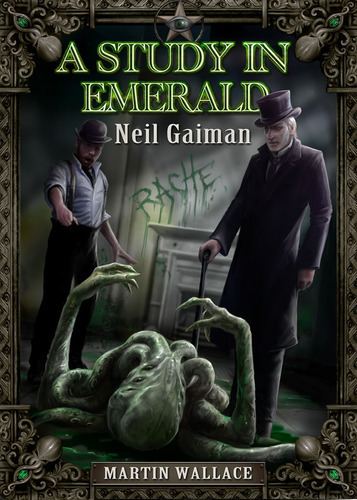8.4 /10 1 Votes
Country United States Publication date 2003 | 4.2/5 Goodreads Language English Originally published 2003 | |||||||||||||||||||||||||||||||||
 | ||||||||||||||||||||||||||||||||||
Media type Print (hardback & paperback) Similar Neil Gaiman books, Hugo Award for Best Short Story winners, Other books | ||||||||||||||||||||||||||||||||||
A study in emerald 2nd edition review with meeple talk
"A Study in Emerald" is a short story written by British fantasy and graphic novel author Neil Gaiman. The story is a Sherlock Holmes pastiche transferred to the Cthulhu Mythos universe of horror writer H. P. Lovecraft. It won the 2004 Hugo Award for Best Short Story. The title is a reference to the Sherlock Holmes novel A Study in Scarlet. "A Study in Emerald" first appeared in the anthology Shadows Over Baker Street, a collection of stories combining the worlds of Arthur Conan Doyle and H. P. Lovecraft; it has subsequently been available as part of Gaiman's short story collection Fragile Things, in the collection New Cthulhu: The Recent Weird, and is available online. The online version takes the form of a Victorian periodical or newspaper, which includes various advertisements that reference characters such as Vlad Tepes, Victor Frankenstein, Spring Heeled Jack, and Dr. Jekyll.
Contents
- A study in emerald 2nd edition review with meeple talk
- Interview neil gaiman on a study in emerald
- Plot summary
- Spin off media
- Awards
- References
In the introduction to Fragile Things, Gaiman cites Philip José Farmer's Wold Newton Universe, Kim Newman's Anno Dracula series (which Gaiman helped create), and Alan Moore's The League of Extraordinary Gentlemen as being the major influences of "A Study in Emerald".
Interview neil gaiman on a study in emerald
Plot summary
The story begins with its (as yet) unnamed narrator, a veteran of a bloody war against the "gods and men of Afghanistan", where he has been brutally tortured and his arm injured, setting the scene for things to come. Seeking lodgings upon his return to England (or "Albion", as it is referred to throughout the story), he meets and strikes up a friendship with a man who possesses extraordinary insight and deductive skill, and who puts this ability to use in the service of the police as a 'consulting detective'. Early on in their acquaintance, Inspector Lestrade of Scotland Yard arrives at their lodgings in Baker Street with a matter of extreme and delicate urgency regarding a brutal murder in a Whitechapel slum, and the detective is to be hired to solve the case. After investigating the murder scene (where the detective correctly deduces that the victim is an alien noble from Germany, owing to his inhuman appearance and number of limbs), and puzzling over the word Rache scrawled onto the wall in the victim's blood (echoing a scene from A Study in Scarlet), they are taken to the Palace. The Queen, one of the Great Old Ones who defeated Humanity 700 years ago and now rule the world, consults with them about the affair. As payment for his service, the Queen heals the veteran's withered shoulder with a touch.
The investigation takes the detective and the veteran to a music hall show, starring a noted actor called Sherry Vernet. A "tall, languid" man, Vernet stars in three productions, including a historical narrative depicting the war between Humanity and the Great Old Ones. Posing as a theatrical agent offering to take the show to the New World, the detective meets Vernet and quickly determines that he and another, a man with a limp and skill with surgical equipment, were present in the room where the German noble died. Agreeing to meet the detective in his rooms, Vernet seemingly does not suspect a thing; the detective promptly summons Lestrade, intending to have Vernet arrested. He reveals what he has deduced: that Vernet is a seditionary "restorationist", an anarchist who believes that the Old Ones are not the benevolent rulers they claim, but vicious, soul-destroying monsters from whom Humanity must be freed. Vernet lured the German noble to the Whitechapel rooms and turned the noble over to his accomplice, who committed the actual murder.
Vernet possesses considerable deductive skill, having deduced that the detective was not who he claimed to be. Posing as "Sigerson", Vernet had briefly corresponded with the detective, offering suggestions for future undercover work and complimenting him on several papers the detective had written, including "The Dynamics of an Asteroid". Vernet, who also uses the alias "Rache", leaves a letter confirming the detective's suspicions, and details horrors committed by the Old Ones as justification for the crime. As Lestrade rushes off to search for Vernet and the limping accomplice (tentatively identified as a former military surgeon named John Watson), the detective admits that it is unlikely that Vernet has left the city, having probably elected (as the detective would) to hide in the lawless depths of the rookery of St Giles. He requests that the veteran burn Vernet's letter, dismissing it as seditionary nonsense. The veteran does not do so, instead adding a copy of the letter and an account of the investigation to his bank deposit box, not to be opened until everyone involved in the case is dead. He supposes that due to current events in Russia that this will likely be an imminent occurrence.
The story is signed "S_____ M______, Major (Ret'd)".
Spin-off media
British game designer Martin Wallace announced a boardgame based on "A Study in Emerald", that was released in October 2013
Awards
"A Study in Emerald" won the 2004 Hugo Award for Best Short Story, and the 2005 Locus Award for Best Novelette. It was nominated for the 2006 Seiun Award for Translated Short Form.
